 Phalaenopsis Orchid Care
Phalaenopsis Orchid Care Dendrobium Phalaenopsis Type Orchid Care
Dendrobium Phalaenopsis Type Orchid Care Cymbidium Orchid Care
Cymbidium Orchid Care Paphiopedilum Orchid Care
Paphiopedilum Orchid Care Oncidium and Odontoglossum Ochid Care
Oncidium and Odontoglossum Ochid Care Cattleya Orchid Care
Cattleya Orchid Care Miltonia Orchid Care
Miltonia Orchid Care
Orchid Care: Phalaenopsis
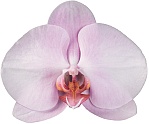
Phalaenopsis (fah-lay-NOP-sis)
Phalaenopsis, commonly referred to as the “Moth Orchid,” are considered one of the easiest orchids to grow in the home. The long lasting flowers bloom in perfection for up to three months. While the flowering season may vary, the plant can bloom more than once during the year. Phalaenopsis have become one of the most popular varieties of orchids due to their easy care and delicately poised vibrant floral formations.
Temperature: Day 70°-90° F, Night 60°-70° F
Water: Every 1-2 weeks. Keep evenly moist. Avoid wet foliage at night. Do not allow roots to sit in standing water.
Light: Moderate indirect light. No direct sun
Fertilizer: 1-2 times a month, less in winter, never fertilize a dry plant
Humidity: Phalaenopsis enjoy moist air 55-75% humidity is ideal. Humidity can be increased by placing plant over a tray of water with some pebbles or rocks etc. to raise the pot above the water.
Repotting: Plants should be repotted every other year. Since Phalaenopsis grow upwards, they can be repotted into the same sized pot. Sphagnum moss works well with the base of the bottom leaf at the surface of the medium. Water sparingly until new roots are established. One advantage of using sphagnum moss is that you can wrap a bit more moss around the old root ball and place it into another pot. Do not place in a draft, near a heater or dehumidifier.
Orchid Care: Dendrobium – Phalaenopsis Type
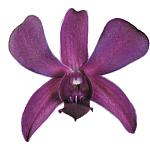
Dendrobium- Phalaenopsis Type (den-droh-bee-um)
Most Dendrobium orchids are called “Phalaenopsis type” because their flowers resemble those of the Phalaenopsis. Phalaenopsis type are evergreen, while other varieties of Dendrobium shed their leaves in the fall and winter. Dendrobiums are also commonly used as cut flowers because of their sturdy stems and distinctive coloring.
Temperature: Day 70°-90° F, Night 60°-65° F
Water: Allow to dry slightly between waterings
Light: Bright indirect light
Fertilizer: Twice a month, less in winter
Repotting: Repot once every two years in spring after blooming or when new growth starts. Medium grade fir bark works well in 4″ pots and larger.
Orchid Care: Cymbidium
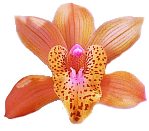
Cymbidium (sym-BID-ee-um)
There are two basic types of Cymbidiums: standard and miniature. Generally, the miniatures bear smaller, but more, flowers than the standards and bloom somewhat earlier. Most miniatures bloom from November through March, while standards bloom from late December through May. Cymbidiums are basically cool-growing orchids, and best grown outdoors or in cool greenhouses.
Temperature: Cymbidiums will tolerate considerable summer heat as long as they get cool, mild night temperatures between 45°-60°F. Cold weather, even down to 28°F for a few hours each night, will not damage an acclimatized plant, but once the plant spikes or flowers, it should be protected from temperatures below 35°F. Plants should always be kept free of frost.
Water: Cymbidiums should not be allowed to go dry, but should not be over watered either. Water once a week making adjustments for warmer or cooler weather.
Light: Plants should receive morning or afternoon sun, yet should be protected from the hot midday sun. A light green leaf with just a hint of yellow indicates the maximum amount of sun the plant can take, and a dark green leaf indicates not enough sun.
Fertilizer: Twice a month, less in winter.
Repotting: Repot every 2-3 years from February to June with a well draining potting medium. Fine bark is suitable in mild summer climates, while a finer potting medium works well in warmer summer areas.
Orchid Care: Paphiopedilum
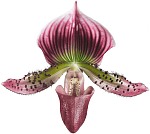
Paphiopedilum (paff-ee-oh-PED-ih-lum
The exotic, wax-like, richly colored blooms last for weeks sometimes months! They are ideal for home growing. Paphiopedilum, also known as Lady Slippers, have no pseudobulb but are made up of attractive, glossy green leaves. After leaves are fully formed, the flower stem rises from the center of the newly developed growth.
Temperature: Paphiopedilum are divided into two temperature groups: warm and cool growers. The attractive mottled-leaf types come from the warmer temperature zones and do best with a night temperature above 60°F (preferably 65°F), and day temperatures of 75-85°F. The solid green-leaved types come from the higher, cooler altitudes. They require a night temperature of 55-65°F and a day temperature of 70-80°
Water: Paphiopedilum must be kept constantly moist but not soggy. Check frequently below the surface to determine the need for water.
Light: Place in any bright window but protect from midday sun. Leaves should be a medium green color; if they are to pale or yellowish, the plant could be getting too much light. (Approximately the same light intensity as African violets is preferred.)
Fertilizer: Fertilize twice a month at half strength or less. Paphiopedilum are sensitive to fertilizer burn. Make sure the potting mix is moist before fertilizing.
Repotting: Paphiopedilum should be repotted every 2-3 years with a fresh well-draining potting medium; such as fine grade fir bark. It is important that the base of the growths be potted no deeper than in the medium.
Orchid Care: Oncidium and Odontoglossum
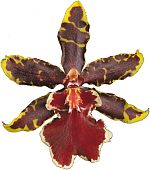
Oncidium (on-SID-ee-um) and
Odontoglossum (o-don-toh-GLOSS-um)
The Oncidium variety of orchids are becoming very popular for ease of growing and long lasting sprays of small, distinct flowers which often have unique color combinations and a pleasant fragrance. They will typically bloom once a year and can be grown in the home, as well as in a sheltered area in the garden. Oncidium have been combined with Odontoglossum and other related orchid types through hybridizing to offer a seeming endless array of striking color patterns
Temperature: Day 70°-85° F, Night 60°-65° F
Water: Water 5 to 7 days, allow to dry slightly between waterings
Light: Bright indirect light. No direct sun
Fertilizer: Twice a month, less in winter
Humidity: Odonts/Oncidium enjoy moist air, requiring a minimum of 40-50% humidity in the immediate vicinity of the plant. Humidity should be increased with higher temperatures. The ideal humidity is 55-75%, with as much ventilation or air movement as possible without any cold drafts. Humidity can be increased around the plant by placing the pot on an inverted saucer in a baking pan filled with pebbles, rock chips, etc. and water. Keep water level top of pebbles so that plant will not have “wet feet” from setting in water. Morning misting of foliage is also helpful, especially during periods of hot weather.
Potting: Repot Odonts and Oncidium at least every 2 years. As a general rule, repot them when the new shoot is 2-3″ tall or when new roots appear. All the old mix and any dead roots should be removed. If dividing, keep the divisions in clumps of 3-5 mature bulbs. Fir bark is preferred. The base of the new growth should be potted about 1/2″ (no deeper) into the fresh bark. Keep mix barely damp until you see the new roots penetrating the bark, then resume normal watering.
Orchid Care: Cattleya
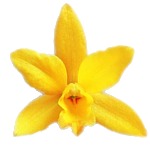
Cattleya (KAT-lee-ah)
Cattleyas have earned the reputation as the “Queen of Orchids” and are known to the public as the ultimate floral corsage. While some naturally occurring cattleya species are offered by growers, the most popular plants are man-made hybrids.
Temperature: Day 70°-85° F, Night 55°-65° F
Water: Cattleyas grow best when their potting medium becomes dry between waterings. These plants are epiphytes in nature (i.e growing on top of trees) and are used to drying out between the rains.
Light: Cattleyas and their relatives enjoy full sun in the morning, but will require shading from about 11 am – 3 pm; less shading will be necessary in the late afternoon. Their leaves should be a light green color. Darker green leaves indicate too little sun.
Fertilizer: Fertilize twice a month, less in winter
Repotting: Cattleyas can be repotted almost all year around. Plants recover faster if repotted as the new shoots are emerging or immediately after the blooms fade. A coarse medium, such as medium grade fir bark, or coarse grade fir bark will work well. Repot every 2-3 years.
Orchid Care: Miltonia
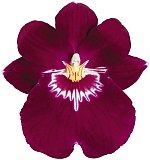
Miltonia (mil-TOH-nee-ah)
Temperature: Columbian Miltonia (Miltoniopsis) like house temperatures of nights from 58° – 68°F and days from 70° – 80°F. Brazilian Miltonia (spectabilis, warscewiezii, Anne Warne, and clowesii) prefer warmer temperatures of 60° – 65°F night and 70° – 80°F days.
Water: During overcast days, water carefully and do not allow water to stand in the leaves or soft rot may occur. Always water in the morning so foliage is not moist at night. Keep roots damp but never over water. Crinkled leaves are a sign of insufficient water. Water thoroughly from the top of the pot, allowing water to flow freely through the pot and away from the plant. Never use artificially softened water. Never allow the bottom of the pot to stand in water.
Light: Grow near or in a window avoiding the direct hot rays of the midday sun. From 1,500 to 4,000 foot candles of light is preferred. Always adjust plants gradually to higher light intensities.
Fertilizer: Fertilize approximately twice per month when new growth is developing. Once per month at half strength all other times.
HUMIDITY: Miltonia enjoy moist air, requiring a minimum of 40-50% humidity in the immediate vicinity of the plant. Humidity should be increased with higher temperatures. The ideal humidity is 55-75% with as much ventilation or air movement as possible without cold drafts. Humidity can be increased around the plant by placing the pot on an inverted saucer in a baking pan filled with pebbles, rock chips, etc. and water. Keep water level below top of pebbles so that plant will not have wet feet
Repotting: Plant in bark allowing room in pot for about 2 new growths. Do not over-pot. Repot every 2 years directly after spring blooming. The plant may be divided at the time of repotting if it is large enough to allow divisions of 3-5 bulbs. Large showy plants can be grown by simply moving the plant to a larger pot. In pots larger than 6 diameter, use very shallow pots.